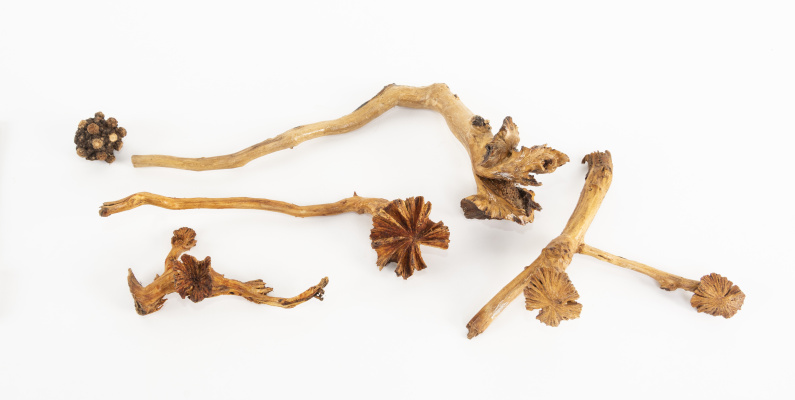
Parasitism in plants is a life strategy that has evolved independently many times around the world. Parasitic species rely on other plants (their hosts) for nutrients and represent about 1% of all flowering plant diversity. They include species that produce the world’s largest flowers, like the tropical Rafflesia, tiny-flowered ones such as our native mistletoes, and New Zealand’s endemic Dactylanthus taylorii, which produces flowers so strange they don’t resemble flowers at all.
…
Dactylanthus taylorii lives mostly underground, growing in darkness. With no roots or green leaves of its own, it depends completely upon a host plant for nutrients—if it cannot attach itself to one as a seed, it does not survive.
The germinating seed is approximately the size and shape of a grain of rice and must drop right beside a suitable host to have a hope of reaching one of its roots. Helpfully, Dactylanthus is compatible with over 30 different species of native hardwood trees and shrubs, with a particular fondness for broadleaved plants common to early succession forests. These include New Zealand broadleaf (Griselinia littoralis), five finger (Pseudopanax arboreus), and black matipo (Pittosporum tenuifolium).
It is still a mystery how Dactylanthus attaches to its host’s roots, but once affixed, the seed develops into a bloated stem. The host root also undergoes a transformation, with the attachment points radiating into structures that look like fluted wooden flowers.

Botanical drawing of Dactylanthus taylorii attached to a host plant. Joseph Hooker, 1859.
Known as ‘wood roses’, these flower-like growths were once commonly harvested in New Zealand, a practice that is now illegal on public lands. Many wood roses were sold as curios, made into mantlepieces, or kept as heirlooms. During the 1970s, Oamaru local Douglas Amoore collected 30 wood roses from the bush at the southern end of Lake Taupō, near Tūrangi. He donated his collection to the Museum last year.

Varnished wood rose specimens created by Dactylanthus taylorii. Small D. taylorii tuber on the top left. Tūhura Otago Museum collection.
After four years of growing underground, Dactylanthus is ready to put out some flowers of its own. Between February and April, clumps of florets emerge from the forest floor, their fleshy stalks coated in brown scales. In te ao Māori, things that live underground are believed to have strong associations with the spirit world, and Dactylanthus is accordingly known as ‘pua o Te Rēinga’ (flower of the underworld) or ‘waewae te atua’, which means ‘feet of the gods.’

Dactylanthus taylorii flower and tuber. The inside of a live plant is moist and spongy while the outside looks warty and bumpy. Image by A Holzapfel/DOC.
On younger plants, these otherworldly floral clumps tend to be mostly female flowers; on older plants, there are more males. The flowers produce a profusion of rich nectar which smells faintly of sweat. It is sought after by many insects, birds, and mammals—among them, Dactylanthus’ chief pollinator, the threatened New Zealand short-tailed bat (Mystacina tuberculata). Mice, too, can be effective pollinators, but they are poor seed dispersers.
Unfortunately for Dactylanthus, its sugar-rich nectar also attracts the attention of brushtail possums, rats, and pigs, which damage the flowers before they can produce seeds. A healthy clump of flowers may produce thousands of seeds, but damaged or very old plants may not be able to produce any seeds for many years.
Dactylanthus also faces threats from overharvesting by humans, habitat destruction, and the decline of its natural pollinators and seed dispersers. Conservation efforts have included classifying it as a protected species, work to control possum populations, and the installation of protective cages around the plants to prevent predation and trampling. In recent years, people have also made efforts to sow seeds on suitable host plants and establish new populations in protected reserves, such as Zealandia, Ōtari-Wilton's Bush, and Ngā Manu Nature Reserve.

Cages protecting Dactylanthus plants in the Taranaki area. Image by naturewatchwidow, CC-BY. inaturalist.org/observations/177469099
Today, the species is known only from the North Island, but Dactylanthus pollen has been found embedded in fossilised kākāpō scat from north-west Nelson, confirming the plant once lived in the South Island too.
Perhaps it still does.
In May this year, a wild population was discovered in the Wainuiomata Water Collection Area near Wellington, where the species had been thought extinct for over a century. Somewhere in the rugged expanse of Te Waipounamu, Dactylanthus may yet be secreted beneath the soil, quietly fashioning those wooden flowers.
References and Recommended Further Readings
de Lange PJ. (2025): Dactylanthus taylorii Fact Sheet (content continuously updated). New Zealand Plant Conservation Network. nzpcn.org.nz/flora/species/dactylanthus-taylorii/
Department of Conservation. www.doc.govt.nz/nature/native-plants/dactylanthus/
Ecroyd CE. (1996). THE ECOLOGY OF DACTYLANTHUS TAYLORII AND THREATS TO ITS SURVIVAL. New Zealand Journal of Ecology, 20(1):81–100. jstor.org/stable/24053736
Hill H. (1926) Dactylanthus taylori. Transactions of the New Zealand Institute, 56:87-90, pl. 14-17. paperspast.natlib.govt.nz/periodicals/TPRSNZ1926-56.2.7.1.13
Holzapfel SA, Dodgson J, and Rohan M. (2016) Successful translocation of the threatened New Zealand root-holoparasite Dactylanthus taylorii (Mystropetalaceae). Plant Ecology 217(2):127–138. doi.org/10.1007/s11258-015-0556-7
Hooker JD. (1859) On a new Genus of Balanophoreae from New Zealand, and Two Species of Balanophora. Transactions of the Linnaean Society, 22:425-428 doi.org/10.1111/j.1096-3642.1856.tb00114.x
Hølleland H. (2017). Caged for Protection: Exploring the Paradoxes of Protecting New Zealand’s Dactylanthus taylorii. Environment and History, 23(4):545–567. jstor.org/stable/26401790
Teixeira-Costa L and Davis CC. (2021). Life history, diversity, and distribution in parasitic flowering plants. Plant Physiology, 187(1):32–51. doi.org/10.1093/plphys/kiab279
